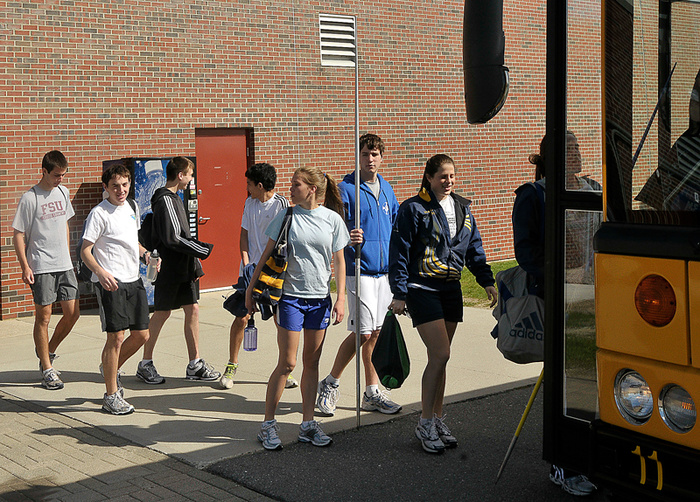FALMOUTH — Four runners trot into the parking lot as a shot putter practices his form, heaving a 12-pound apparatus from a concrete path onto the lawn at the side of the school. Nearby there’s the beeping of a vehicle backing into a construction area, which becomes louder as the shot putter goes to pick up the 12-pound lead weight out of the grass.
Where the track and multi-purpose athletic field at Falmouth High once stood, an elementary school complex is being erected, scheduled to open in the fall of 2011. A new stadium with an artificial playing surface and an eight-lane track won’t be finished until the fall.
As a result, the Falmouth outdoor track team temporarily has been displaced.
“I don’t know if we were prepared for this, but we knew it was coming,” Falmouth Coach Danny Paul said.
Construction began in November, hours after the Falmouth boys’ soccer team defeated Yarmouth for the Western Class B title. The next morning, Paul arrived at school to find that the track was already gone, making way for the construction of a new elementary school. Now, nearing the midway point of the outdoor track season, the Yachtsmen are splitting their practices between Gray-New Gloucester’s outdoor track facility and the non-track facilities at Falmouth High.
“The coaching staff has been great about this,” Falmouth Athletic Director Todd Livingston said. “Everybody in the athletic department realized that there’s going to be some interruption. It’s a transition.”
NEED FOR INNOVATION
Falmouth’s situation is temporary. But for other track teams in the area, not having track and field facilities is a daily reality, and it has forced several coaches to get creative in their training methods.
At Freeport, the Falcons practice at Bowdoin Collegein Brunswick, a 10-mile drive from the school, but were not allowed access for practices until after the start of the outdoor track season.
“We go there as much as we possibly can because that’s what the sport is,” Freeport Coach Brian Berkemeyer said.
Track and field, Berkemeyer said, is not a school-sponsored event at Freeport, and athletes pay $100 a season to compete, while boosters raise funds to pay for meet fees. Freeport currently has 37 boys and girls on its track team, and because there is no track at the school, Berkemeyer has had to get creative with his existing resources.
He and his assistant coach, Josh Zola, emphasize not only running work but core strengthening and physical fitness. Berkemeyer has even placed lines for the 100-yard dash and mile markers on the streets in Freeport.
“It’s a huge time commitment to figure out the logistics,” Burkemeyer said. “If we did have a track, our numbers would be greater and we’d get more physically fit. It would be beneficial for the entire school and the entire town to have its own track.”
North Yarmouth Academy, which has won the past four Class C titles in boys’ outdoor track and field, practices at Greely High School. Deering High School in Portland also does not have track facilities on its campus, and outdoor track coach Dick Kress said that like Freeport, the Rams’ coaches emphasize physical fitness and conditioning in their team’s training.
“It’s amazing that we’ve won state championships and won Southwesterns with no facility,” said Kress, who has been coaching track at Deering since 1979. “We’re the largest school in the state without a facility.”
Bruce Koharian, who also coaches track at Deering, saw the participation numbers decline after Deering won its last state titles in 2004 (boys’ indoor and outdoor track).
“I attribute it to not having facilities,” Koharian said. “But with that, you have to be positive. You can always get kids to come out for track. We’ve never had a track, but we’ve always had a track program, probably since the school opened in the 1920s. You can coach anywhere and you can run anywhere.”
VARIETY OF CONDITIONS
At Waynflete, 16 students utilize the surroundings of their West End campus to train, running hills or along the Western Promenade. Once a week, the Flyers practice at Fitzpatrick Stadium – they run to and from the stadium for that practice.
“I want to have the kids outdoors,” Waynflete Coach Brian Gillespie said. “There’s no real facility set up at Waynflete, and when we get to Fitzpatrick, we make do with what we have. It gives the long jumpers a chance to jump, and it gives kids a feel for the texture of the track.
“It is a negative. But if you’re creative, you do what you can.”
And, he adds, “It’s almost the job of the coach to be innovative.”
Falmouth’s track athletes do speed workouts at The Woodlands, and the distance runners take to the roads in town. Three days a week, the team splits into three groups and buses to Gray-New Gloucester – Monday is for those running the 200 and 400, as well as the jumpers and some of the throwers. Tuesday, the pole vaulters and other throwers train. Wednesday, the hurdlers and sprinters take their turn.
The facilities are necessary. Landings in the hurdles aren’t negotiable on many other surfaces, and jumping pits are a staple. And the Yachtsmen’s throwers won’t even attempt to launch a discus or a javelin inside the school gymnasium.
“I look at the clipboard every day,” Paul said, “and I think ‘I hope this works.’ ”
ORGANIZATION IS KEY
Because their time on a track this season is finite, several of Falmouth’s athletes have found they need to compartmentalize their time.
“The biggest challenge has been just the fact that you have to figure out what to do every day,” said Andy Kowalsky, a junior who throws the shot and javelin. “But the benefit of it is that you know when you need to throw hard once or twice before a meet. You don’t overthrow.”
The pole vaulters have limited time to work in the pits. During the winter, they worked indoors or were bused to Bates College in Lewiston or to the University of Southern Maine in Gorham.
“It’s harder for the new vaulters to get used to vaulting,” said Corey Morganstern, a pole vaulter. “Once or twice a week we practice and compete at our own meets, and that’s the only chance we really get to vault.”
But there’s also a drawback for when it comes to creating team chemistry – still a necessary factor for a team that fields 123 athletes this spring.
“Since different people go on different days, you don’t see the people whom you’d usually see every day,” said Kate Sparks, who throws the shot, discus and javelin. “But it’s good because it forces me to work on my technique and other things besides just throwing, things like lifting and technique.”
Livingston said that a new stadium for the Yachtsmen is scheduled to open in the fall, with an artificial playing surface and an eight-lane track he believes will be ideal to host a championship meet.
But when asked if he’s ever known about a situation like this, Paul chuckles.
“I coached at Greely in the 1980s, and the year before the track was built, Greely won the state championship,” he recalled. “It kind of became a joke. ‘Why build a track?’ ”
Staff Writer Rachel Lenzi can be reached at 791-6415 or at: rlenzi@pressherald.com
Send questions/comments to the editors.




Success. Please wait for the page to reload. If the page does not reload within 5 seconds, please refresh the page.
Enter your email and password to access comments.
Hi, to comment on stories you must . This profile is in addition to your subscription and website login.
Already have a commenting profile? .
Invalid username/password.
Please check your email to confirm and complete your registration.
Only subscribers are eligible to post comments. Please subscribe or login first for digital access. Here’s why.
Use the form below to reset your password. When you've submitted your account email, we will send an email with a reset code.